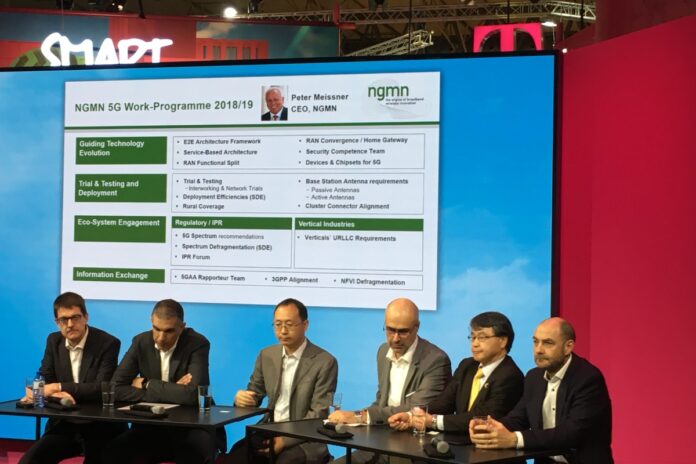Determined to show they mean business with 5G, their pilots vary from aeronautics to entertainment, remote healthcare, smart energy and factories.
Senior execs from operators gave their short presentations at a press conference hosted by standards body NGMN at MWC last week: NGMN kicked off 5G as we now know it with a white paper back in 2015.
It continues to be a major influence on the evolution of the technology, working with others including 3GPP and the Broadband Forum.
The presentations were introduced by Orange’s Emmanuel Lugagne Delpon who is also chair of NGMN’s board. He stressed that “strong and continuous engagement between operators and vertical Industries in tests, trials and prototype solutions is key to make these use cases and prototypes a reality”.
He said the following outlines of ongoing pilot schemes show “practical use cases that have been realised jointly with our industry partners”. Clearly from what came next, campus networks are looming large in many operators’ minds alongside immersive technologies (virtual and augmented, or as Microsoft describes it, ‘mixed’) reality for industrial and field purposes.
Emmanuel Lugagne Delpon, Senior Vice President at Orange Labs Networks, started the proceedings. He talked about how Orange is looking at how immersive technologies – such as augmented and virtual reality – can be used in industry. One pilot is using these technologies to explore improving time to repair in aeronautics.
Workers on the factory floor can see things like schematics on the visor screens and communicate with colleagues while keeping their hands free – and the work can be double checked more efficiently. Using these techs, companies will be able to run virtual maintenance centres and provider richer training and certification, according to the operator.
Luke Ibbetson, head of the Vodafone Group Research and Development organisation, talked about Smart factories and industry automation, and how 5G could enable the transition from cabled factory infrastructure to fully wireless and mobile.
Dispensing with cables might not sound exciting, but they are immensely expensive to install and limit the configuration options within factories because of the expense and time involved in moving or changing them.
Vodafone’s vision is to connect tools, assembly stations, machines, autonomous vehicles and, presumably, people. Like DT, it intends to combine, seamlessly, private and public networks to provide dedicated radio coverage, capacity planning for factories and warehouses, and local compute for AI to the shop floor.
These will be enabled through public and private cellular networks that are optimised that are reliable, how low latency but high bandwidth, and service guarantees.
Deutsche Telekom’s Arash Ashouriha is SVP, Group Technology Innovation & deputy CTO. He explained how the company is looking at campus networks for smart manufacture, pointing to the previous day’s press conference on its work with the light technology company OSRAM. He stressed the unique ‘dual slicing’ aspect, and the advantages of combining public and private cellular connectivity for campus networks.
Igal Elbaz, SVP, Wireless Network Architecture and Design, AT&T, also spoke about campus networks, but this time in the entertainment industry, and specifically about using startup Magic Leap’s AR tech, to which the operator has exclusive rights wireless distribution rights in the US.
AT&T built a 5G zone at Magic Leap’s Plantation HQ in Florida in 2018, and is working with the company to develop solutions for business. Magic Leap has raised over $2 billion from investors including Google, J.P. Morgan and Alibaba.
Guangyi Liu is the CTO of Wireless & Device Department and leads the 5G R&D activities at China Mobile. His firm is running pilots for smart grid to optimise power production, transmission and consumption by connecting nodes right across the electricity lifecycle. He said smart power grids should be self-healing, safe, economical and enable a clean grid that provides high quality electricity.
Seizo Onoe, President at DOCOMO Technology, spoke about how 5G can improve remote healthcare and eliminate the inequality of access to services and treatment. A pilot scheme currently links Wakayama Medical University Hospital by a 4K video link to a remote clinic 40km away and a mobile clinic.



